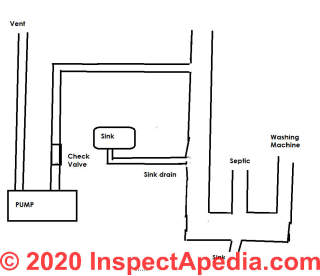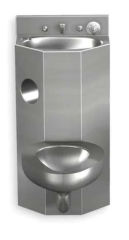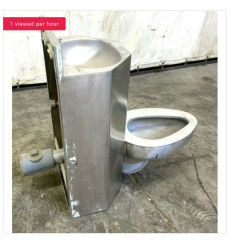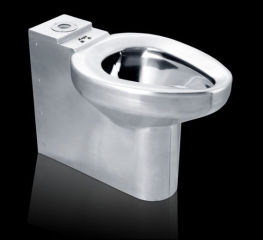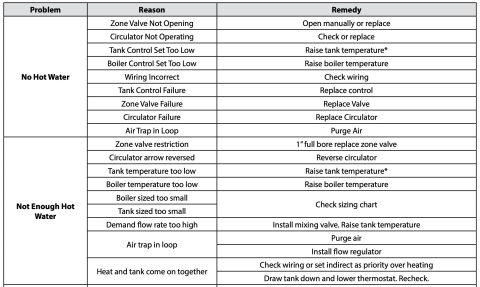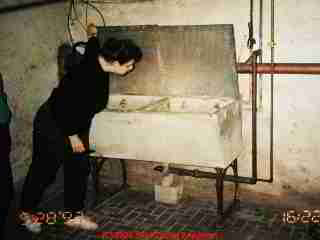 Plumbing System Installation & Repair
Plumbing System Installation & Repair
Home Page & Article Index
- POST a QUESTION or COMMENT about plumbing system inspection, diagnosis, testing, & repairs
This page provides an index to key plumbing installation, troubleshooting and repair articles.
These articles include describing plumbing systems, piping, and components.
These plumbing repair articles answer nearly all questions about diagnosing and repairing building plumbing systems, including water supply and drain piping, vent piping, gas and oil piping in buildings, plumbing fixtures, water heaters, water pumps, water pressure, water softeners, water testing, water treatment equipment, water wells, and septic systems.
We also explain oil tanks, water tanks, as well as other building plumbing system inspection or defect topics.
Use our on page search box to also find separate articles on the installation, diagnosis, & repair of septic systems, sewer systems, & building mechanical systems including pumps & wells.
InspectAPedia tolerates no conflicts of interest. We have no relationship with advertisers, products, or services discussed at this website.
- Daniel Friedman, Publisher/Editor/Author - See WHO ARE WE?
Plumbing System Diagnosis and Repair Guides
 This InspectAPedia page provides links to both article indexes by major plumbing topic and links to in-depth articles on inspecting, testing, and repairing problems with
above ground and buried oil tanks, septic system design, inspection, testing, water supply and drain waste vent piping, wells, water supply pumps, water tanks,
water testing and water treatment.
This InspectAPedia page provides links to both article indexes by major plumbing topic and links to in-depth articles on inspecting, testing, and repairing problems with
above ground and buried oil tanks, septic system design, inspection, testing, water supply and drain waste vent piping, wells, water supply pumps, water tanks,
water testing and water treatment.
Below on this page we describe the contents of key plumbing system articles and indexes organized by major plumbing system topics.
[Click to enlarge any image]
To find what you need quickly, if you don't want to scroll through this index you are welcome to use the page top or bottom SEARCH BOX to search InspectApedia for specific articles and information.
Drinking Water Tests, Water Contamination Limits, Drinking Water Testing Procedures
- Home page for drinking water contamination, potability, testing:
DRINKING WATER CONTAMINATION, TESTS, LIMITS, PROCEDURES
Fixtures, Plumbing: Sinks, Tubs, Showers, Toilets, Toilet Alternatives
- Home page for plumbing fixtures:
PLUMBING FIXTURES, KITCHEN, BATH
- Home page for toilets:
TOILETS, INSPECT, INSTALL, REPAIR
Also see CRANE PLUMBING & HEATING CATALOG 1950 [PDF]
Gas Piping in buildings
- Home page for gas piping:
GAS PIPING, VALVES, CONTROLS
Hot Water Systems: Water Heaters
- Article Index for water heaters:
ARTICLE INDEX to WATER HEATERS - master index to articles about hot water systems - Home page for water heaters:
WATER HEATERS - hot water tanks, sources of hot water in buildings, equipment installation, troubleshooting, repair.
We address just about any question you may have about residential or light commercial hot water supply systems, including identifying types of water heaters, inspecting water heaters, diagnosing hot water supply problems, installing and repairing water heaters, water heater maintenance.
Oil & Gas Fuel Supply Piping and Tanks

- Article Index for oil storage tanks, piping, etc:
ARTICLE INDEX to HEATING OIL, OIL BURNERS, OIL FIRED HEATERS, OIL TANKS
- Home page for gas piping:
GAS PIPING, VALVES, CONTROLS - Home page for heating oil tank piping:
OIL TANK PIPING & PIPING DEFECTS - Home page for heating oil storage tanks:
OIL TANKS - Buried or Above Ground Oil Tank Inspection, Testing, Cleanup, Abandonment of Oil Tanks
Plumbing Information Master Index
- ARTICLE INDEX to BUILDING FREEZE PROTECTION
- ARTICLE INDEX to DRAIN SEPTIC SEWER PIPES
- ARTICLE INDEX to GAS APPLIANCES, PIPING, CONTROLS
- ARTICLE INDEX to HEATING OIL, OIL BURNERS, OIL FIRED HEATERS, OIL TANKS
- ARTICLE INDEX to PLUMBING VALVES
- ARTICLE INDEX to SEPTIC DRAINFIELDS & DBOXES
- ARTICLE INDEX to SEPTIC SYSTEMS
- ARTICLE INDEX to SEPTIC TANKS
- ARTICLE INDEX to T&P RELIEF VALVES
- ARTICLE INDEX to TOILET INFORMATION
- ARTICLE INDEX to WATER HEATERS
- ARTICLE INDEX to WATER SUPPLY, PUMPS, TANKS, WELLS
- ARTICLE INDEX to WATER TESTING
- ARTICLE INDEX to WATER TREATMENT SYSTEMS
Plumbing Codes, Citations, Full Text Codes, & Plumbing Code References
 Watch out: for the US, the 2015 IPC is the most recent version of the International Plumbing Code, while the 2018 IPC is under development.
Watch out: for the US, the 2015 IPC is the most recent version of the International Plumbing Code, while the 2018 IPC is under development.
To understand which generation of the model building code or plumbing code applies to your specific project, you will need to check with your local building official. For example, many jurisdictions are on the 2012 IPC or still older versions.
- International Code Council, 500 New Jersey Avenue, NW, 6th Floor, Washington, DC 20001
Tel: 1-888-ICC-SAFE (422-7233); Fax: (202) 783-2348
International: (202) 370-1800, Email: webmaster@iccsafe.org, Website: www.iccsafe.org
Excerpt describing the IPC - International Plumbing Code
The International Plumbing Code (IPC) is a proven, comprehensive model plumbing code that works seamlessly with ICC's family of building codes. It sets minimum regulations for plumbing systems and components to protect life, health and safety of building occupants and the public.
The IPC is available for adoption by jurisdictions ranging from states to towns, and is currently adopted on the state or local level in 35 states in the U.S. The IPC is built on the proven legacy of the BOCA National Plumbing Code, SBCCI Standard Plumbing Code, and ICBO Plumbing Code.
The IPC sets minimum regulations for plumbing systems using both prescriptive and performance-related provisions ...
Purchase the 2015 International Plumbing Code at this ICC page: http://shop.iccsafe.org/codes/2015-international-codes-and-references/2015-international-plumbing-coder.html - 2012 IPC INTERNATIONAL PLUMBING CODE - COMPLETE [OFFLINE - at demand of ICC, previously MARYLAND-Plumbing_Code_2012_ICC_IPC_Full_Text.php ]] as adopted, incorporated by Maryland - download not available free from ICC - find at UpCodes.] retrieved 2016/08/11, original source: https://law.resource.org/pub/us/code/ibr/icc.ipc.2012.pdf, as adopted by the U.S. State of Code Maryland Administrative Regulations section 05.02.01.02
This public document is the entire 2012 Plumbing Code - 2009 IPC ICC INTERNATIONAL PLUMBING CODE [PDF] [OFFLINE - at demand of ICC] full text, retrieved 2016/08/11, original source: https://law.resource.org/pub/us/code/ibr/icc.ipc.2009.pdf as adopted and incorporated by various U.S. states including Alabama, Colorado, Delaware, Florida, Michigan, New Hampshire, North Carolina, Ohio, Oklahoma, Pennsylvania, Rhode Island, Utah, Vermont, Virginia, West Virginia, and others.
- 2006 IPC ICC INTERNATIONAL PLUMBING CODE[PDF] [OFFLINE - at demand of ICC] full text, retrieved 2016/08/11, original source: https://law.resource.org/pub/us/code/ibr/icc.ipc.2006.pdf as adopted by various U.S. states and municipalities including Arizona, Arkansas, District of Columbia, Georgia, New York, South Carolina, and others.
- 2006 IPC Chapter 9, VENTS (PLUMBING) 2006 Uniform Plumbing Code, complete text as adopted by the Virginia 2006 Plumbing Code
- Gagliardi, Michael G., and Louis J. Liberatore. "WATER SYSTEMS PIPING." in PIPING HANDBOOK (7th Ed.) [PDF] (2000) McGraw Hill, ISBN 0-07-047106-1 - retrieved 2022/07/23, original source: https://d1wqtxts1xzle7.cloudfront.net/
Note that the earliest editions of this book date from 1930 and have been published by McGrawhill at intervals since that year. Copyright 1973. - International Residential Code (IRC), for One and Two Family Dwellings, 2012 (First Printing) Home Page: publicecodes.citation.com/icod/irc/index.htm Citation Page: publicecodes.citation.com/icod/irc/2012/icod_irc_2012_31_sec003.htm
- International Mechanical Code (IMC), International Code Council [888] 422-7233, Op. Cit.
- International Plumbing Code (IPC) (see NPC below), Op. Cit.
- National Standard Plumbing Code, (NPC), 2009 obtained From: National Assoc. of Plumbing-Heating-Cooling Contractors in New Jersey at [800] 652-7422 or NAPHCC [800] 533-7694, [Cited by New Jersey State Department of Community Affairs]
state.nj.us/dca/divisions/codes/codreg/pdf_misc_codes/2006_nspc.pdf - New Jersey State Department of Community Affairs, Website: state.nj.us/dca/divisions/codes/codreg/
- Orlasky, M.J. & R.S. Wyly, PERFORMANCE CRITERIA & PLUMBING SYSTEM DESIGN [PDF], (1978) U.S. NBS Technical Note 966, U.S. Department of Commerce & National Bureau of Standards,
Overview:
An overview is presented indicating how the performance approach to plumbing system design can be used to extend traditional methods to innovative systems. Identification of the plumbing performance needed in a built system is used to classify current design criteria intended to furnish this level of performance.
Some current design criteria may provide a higher level of performance than is actually needed by the user.
In other cases, no standard test method, criterion, or evaluation technique exists. Putting existing knowledge into a performance format increases the utility of this knowledge and facilitates identification of needed research to fill the gaps.
Some of the mathematical models now used for system design and pipe sizing in plumbing codes are reviewed in the context of performance-oriented research.
The results of experimental work in plumbing systems with reduced-size vents (smaller than allowed by codes) are presented as an example of the use of the performance approach, and illustrate a case where performance criteria permit relaxing of vent design practice.
Conceivably the re-examination by plumbing designers of traditional design criteria against measured user needs could be beneficially extended to other areas of plumbing design such as water distribution, storm drainage, and plumbing fixtures.
Beyond this, it has been recognized that uniform guidelines for evaluation of innovative systems , based on research findings, are essential for wide acceptance of performance methods, particularly by the regulatory community.
Septic Systems & Septic Tanks: Onsite Waste Disposal - Septic Systems Inspection & Testing, Problem Diagnosis & Repair Procedures
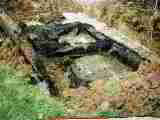
- ARTICLE INDEX to SEPTIC SYSTEMS -
Master index to information about septic systems - Home page for septic systems information:
SEPTIC SYSTEM INSPECT DIAGNOSE REPAIR - Extensive, Detailed Consumer and Industry Information on Septic System Inspection, Testing, Maintenance, Alternatives for on-site waste disposal
Water Supply Piping, Drain Piping, other Building Pipes and Plumbing: piping failures, leaks, and litigation
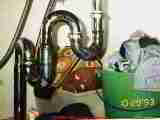
-
Home page for water supply piping information:
SUPPLY PIPING -
Home page for water pipes:
PIPING in BUILDINGS, CLOGS, LEAKS, TYPES -
Home page for drain piping:
DRAIN & SEWER PIPING - WATER HEATERS -
a detailed guide to all types of hot water sources, problems, inspection, repair - WATER PRESSURE LOSS DIAGNOSIS & REPAIR -
how to diagnose and correct poor water pressure in any building - WATER SOFTENERS & CONDITIONERS -
how to treat hard water to avoid pipe clogging and other water problems
Water Supply Piping, & Drain Piping, Water Supply Equipment, other Building Pipes and Plumbing
The following basic water supply information is adapted with permission from Carson Dunlop Associates Home Reference Book.
-
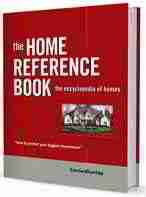 The Home Reference Book - the Encyclopedia of Homes, Carson Dunlop & Associates, Toronto, Ontario, 25th Ed., 2012, is a bound volume of more than 450 illustrated pages that assists home inspectors and home owners in the inspection and detection of problems on buildings. The text is intended as a reference guide to help building owners operate and maintain their home effectively. Field inspection worksheets are included at the back of the volume.
The Home Reference Book - the Encyclopedia of Homes, Carson Dunlop & Associates, Toronto, Ontario, 25th Ed., 2012, is a bound volume of more than 450 illustrated pages that assists home inspectors and home owners in the inspection and detection of problems on buildings. The text is intended as a reference guide to help building owners operate and maintain their home effectively. Field inspection worksheets are included at the back of the volume.
Special Offer: For a 10% discount on any number of copies of the Home Reference Book purchased as a single order. Enter INSPECTAHRB in the order payment page "Promo/Redemption" space. InspectAPedia.com editor Daniel Friedman is a contributing author.
Or choose the The Home Reference eBook for PCs, Macs, Kindle, iPad, iPhone, or Android Smart Phones. Special Offer: For a 5% discount on any number of copies of the Home Reference eBook purchased as a single order. Enter INSPECTAEHRB in the order payment page "Promo/Redemption" space.
For complete water pressure problem diagnosis
see WATER PRESSURE LOSS DIAGNOSIS & REPAIR and see our water pressure diagnostic table
at WATER PRESSURE PROBLEM DIAGNOSIS TABLE.
Also see WATER HEATER PIPING - how are individual or multiple water heaters hooked-up: how are water heater pipes and heaters cascaded, ganged, in series, in parallel
Public Water Supply Piping Properties, Pressure & Flow Problems
If your water supply is from a municipal supply and there are pressure or flow problems, see MUNICIPAL WATER PRESSURE DIAGNOSIS. Excerpts are below.
Typically, the water mains in residential areas are four inches to 12 inches in diameter, and run several feet below the street level.
Smaller pipes, usually 1/2 inch or 3/4 inch diameter, run from city mains into buildings. The water is normally supplied at a pressure of 40 to 70 psi (pounds per square inch).
Typical Water Service Piping from Public Water Main to Building Interior
The 1/2 inch or 3/4 inch diameter service piping carries the water from the street mains to the house. Some early service pipes were 3/8 inch diameter. Most or all of this cannot be seen.
Lead Water Service Piping
Lead piping was used between the street main and the house up until the 1950s.
A good deal of lead supply line is still in use, and the health authorities indicate that as long as it is used regularly, there is no difficulty with it. If the water has not been run for some time, many recommend that the water be flowed for several minutes before using it. The life expectancy of lead piping is indefinite.
See details at LEAD PIPES in BUILDINGS
Other water piping materials: Copper, Galvanized Steel, Plastic
Copper piping has been used extensively since the early 1950s for supply lines from the city main to the house. From 1950 to 1970, 1/2-inch diameter piping was used commonly. After 1970, 3/4-inch diameter copper service piping has been common.
The life expectancy of
copper piping is dependent on water conditions. In many areas, its life expectancy is indefinite. In harsh water or soil conditions, it may fail within 20 years.
- Details are at COPPER PIPING in BUILDINGS
Galvanized steel is not commonly used as a service pipe, although galvanized steel fittings may be found at the point of entry into the house. Where galvanized service piping is used, it is typically at least 1 1/4-inch diameter. The word galvanized means zinc-coated. The coating helps prevent the steel from rusting.
- Details are at GALVANIZED STEEL WATER PIPING
Plastic water service piping may be polybutylene (PB), polyethylene (PE), cross-linked polyethylene (PEX), polyvinyl chloride (PVC) or chlorinated polyvinyl chloride (CPVC).
Most plastic piping is buried at least 18 inches deep. Exposed piping may be subject to mechanical damage and deterioration from sunlight.
- Details are at PLASTIC PIPING ABS CPVC PB PEX PPR PVC
Common Water Service Piping Defects and Problems
Leaks in Water Service Piping
Since the supply line from the street cannot be seen, no comment is offered during a home inspection. If there is a leak, it may go undetected for some time. In some cases, water can be heard running outside the basement wall. Water accumulating in the basement or a wet spot on the lawn is often the first indication.
Leaks may be caused by building settlement, excavation, poor connections, faulty valves or a flaw in the pipe itself.
The underground water service line from the property line to the house is owned by the homeowner. Beyond the property line, the pipe is the responsibility of the city. A leak in the pipe requires excavation, and it is often difficult to know whether the leak is on the city’s or the homeowner’s side.
The city is usually contacted and they excavate their section of the pipe, correcting the problem if they discover it. If no problem is found, the homeowner is left to correct the problem on his or her own. In some cases, the homeowner must pay for the city’s work if the city pipe is not at fault. Some municipalities use sophisticated leak detection equipment.
Low Water Pressure Due to Clogged Service Piping
Poor water pressure in the house may be the result of a partially closed or obstructed valve in the street. It may also be because of blockage, such as a stone or other foreign body in the pipe. New piping may be crimped during installation or become pinched under a rock during back-filling operations. This can also cause low water pressure.
City water mains may be undersized or deteriorated in older neighborhoods. Some cities have poor pumping and/or distribution systems. In these cases, low water pressure problems are usually experienced at every home in the neighborhood. The solution is to petition the city to improve its system.
Water Service Piping Too Small in Diameter
In most new housing, the supply pipe from the street to the house is 3/4-inch diameter. In older houses, the piping was as small as 3/8-inch.
Modern life styles and additional plumbing fixtures usually require a larger line, capable of providing more pressure and volume. Replacing this pipe is an expensive and disruptive job. It is often deferred as long as possible.
Shared Public Supply Service Piping May Cause Poor Pressure or Flow
In some older semi-detached (attached) and row houses, a single supply line would run under a front lawn, and then split to feed two houses. This often yields unsatisfactory water pressure for both houses and is often replaced with two larger, separate lines.
Pressure Regulator Needed on Public Water Supply Piping
Where municipal water pressure is above 80 psi [perhaps even above 70 psi], a regulator is needed and should be provided to reduce the in-house pressure to prevent leaks at fixtures, stress on appliance hoses and possible broken pipe joints.
Details are at WATER PRESSURE REDUCER / REGULATOR
Freeze-Up Problems with Municipal Water Supply Piping
It is unusual, although not impossible, for the service pipe to be too close to the surface, and to freeze during very cold weather. Many service pipes extend above grade just before they enter the house.
Lead Municipal Water Mains or Water Service Piping
Up until World War II, most of the service pipes in built-up areas were lead.
While these generally provide good service, they are small in diameter and may have to be replaced. Also, lead is relatively soft, and if building settlement occurs, there is a chance of leakage or crimping the pipe. Leaks can also occur at connections as a result of long-term deterioration.
Lead Water Service Piping Connected to Steel Pipe Nipple: Leak Risk
Many of the old lead service lines were connected to a galvanized nipple – a short piece of steel pipe that was often in contact with the soil.
This pipe rusts on the outside and inside, and may be close to the end of its life. It is often wise to replace this as a precautionary measure. Galvanized steel service pipes typically last roughly 40 years.
See details at LEAD PIPES in BUILDINGS
- Adapted from Carson Dunlop Associates Home Reference Book.
Water Supply Sources: Wells, Water Pumps, Water Tanks: Inspection, Diagnosis, Installation, Repair, Maintenance
- Home page for water testing: WATER TESTS for CONTAMINANTS
- Home page for water treatment equipment: WATER TREATMENT EQUIPMENT CHOICES
Water Tanks, Water Pumps, Well Pumps
- Home page for water tanks: WATER TANK: USES, TROUBLESHOOTING
- WATER TANK IDENTIFICATION & USE
Wells, Cisterns, Springs: water supply problem diagnosis and repair
- Home page for wells, cisterns, springs: WELLS CISTERNS & SPRINGS - types of sources of drinking water, what they look like, what goes wrong, what to do about it
...
Reader Comments, Questions & Answers About The Article Above
Below you will find questions and answers previously posted on this page at its page bottom reader comment box.
Reader Q&A - also see RECOMMENDED ARTICLES & FAQs
On 2022-11-14 by Mike
@InspectApedia (Editor), Thanks so much. That's exactly what I was thinking.
On 2022-11-13 by InspectApedia (Editor) - clearance distances from a gas appliance vent
@Mike,
If we consider the intention of these clearance distances from a gas appliance vent: to avoid back-drafting exhaust products back into the building should a nearby window be open, then Rinnai's tech support is spot-on. So is your plumber.
Navien's tech support person with whom you spoke may not have understood your exact question, or may have been giving a slightly-more cautious answer.
On 2022-11-13 by Mike
I'm getting different answers from licensed plumbers that have given estimates and the manufacturers(Rinnai and Navien), so I'm afraid to have them begin work without knowing if will pass inspection.
For a gas tankless water heater, the install manuals and IFGC are pretty much the same as far as clearances to operable windows. 12 inches above and 4 ft to the sides, but most are referring to through-the-wall vents/terminals, for indoor units.
For an outdoor appliance, is this clearance requirement specifically for the exhaust VENT of the appliance, or clearance to any part of the entire appliance?
Plumber installing Rinnai says clearance is to the unit, including any pipes.
Rinnai tech support says its to the vent.
Plumber installing Navien says to the vent.
Navien tech support says to the unit.
Thanks!
Attached is a photoshopped image of the proposed location.
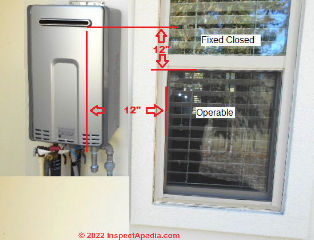
On 2022-10-20 by InspectApedia (Editor) - black and grey water have been leaking under the slab
@Homeowner John,
If I understand you correctly, you actually have two problems both of which are discussed at this website. First you have a broken sewer line that's leaking sewage under the building and into the HVAC duct system.
Secondly you have ducts that run under the floor slab.
If that were my building, rather than go to the expense of trying to sanitize under slab ductwork, I would abandon it entirely as you will find discussed at this website if you search for:
HVAC ducts under concrete floor slab
It sounds as if you need to replace your broken sewer line as well. There are options that can realign buried sewer pipes but I'm not sure that it's cost effective for small residential application.
On 2022-10-20 by Homeowner John
We have a house on a slab foundation. The main sewer drain pipe (cast iron) is in the slab between the kitchen and bath, which share a wall. The bathroom AC duct is located near the pipe. We recently discovered water in the AC duct in the bathroom and have observed that anytime any water is flowing in either the bathroom or the kitchen, a slow trickle comes down the duct into the plenum.
We have a downdraft HVAC system and I have a small hole cute in the metal below the AC unit so I can see what is going on in the plenum in the slab. We had a plumber do a smoke bomb test and found some hazy smoke rising from the slab between the kitchen and bathroom (we removed some drywall to see this).
We had another plumber do a camera down the toilet but could not see a leak. However, water is somehow escaping and getting into the ductwork.
Questions are - 1. is there any reason why we should work harder to pinpoint the leak, or should we just replace the whole pipe? The house was built in 1950 so the cast iron is probably near the end of its life anyways 2. Is there any type of remediation we should do since black and grey water have been leaking under/in the slab for some months now?
On 2021-10-01 by inspectapedia.com.moderator - ask local plumber for solution to 1850 hotel retrofit
@Merce,
Thanks for the interesting photo and question; we don't have a specific neat or tricky product to recommend, but in case it's helpful I'll share with you my opinion that it's pretty rare for us to encounter a construction or plumbing or electrical or mechanical systems problem that nobody has ever run into before, and usually someone has already invented a solution.
Take your question and some photos to your local plumbing supplier and let me know what she suggests.
On 2021-10-01 by Merce
Retrofit question here on an old building originally built in 1850 as a hotel. It is now an apartment building and we are renovating spaces to add more apartments via Covid-Relief money to house homeless folks.
Upon revealing the vent stack, it has a couple 45 degree bends precisely where the plumber wants to tie in with 3 inch PVC . Just below is a 2 inch vent from a bathroom group on the floor below.
Anyone have any insight on how to tie into an existing 4 inch cast iron vent stack in the configuration in the photo? A toilet, shower, bathroom sink, and kitchen sink will drain and vent into this stack. It seems like the dry vent will need to be rerouted above the incoming bathroom group, which should leave room for a Y to bring the new 3 inch PVC bathroom/kitchen into the stack.
Anyone have any better insights or know of any fancy cast-iron/PVC fittings that would make this easier.
Thanks for your time and energies.
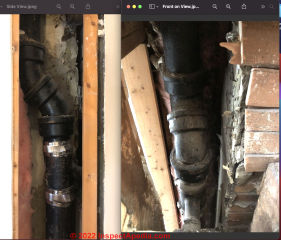
On 2021-09-29 by inspectapedia.com.moderator - how do I fix my water hammer bang?
@Sam,
Please use the on Page search box to search this website for our article on
WATER HAMMER NOISE
And you will see both of description of causes and devices that can correct the problem.
On 2021-09-29 by Sam
I have a well pipe that comes from my submersible 1hp pump into my basement. The pip is 1.25 inch and after the first 3 ft drops to 1.00 inch. The pipe then runs another 50' to the 90gal well Flexcon tank. When the well pump stops the pipes bang.
The pipes are strapped down firmly. The tank, 40/60psi switch and check valve have all been replaced. The tank bladder pressure is around 38psi. Still the bang occurs. The bang seems to occur in the four 90 degree elbows starting at the bladder tank and working its way back to each of the elbows.
I was told the bladder tank is a big hammer arrestor so adding a water hammer arrestor before the check valve and tank would do nothing to stop the bang. So how do I stop the banging? Could the change in pipe size have anything to do with the banging?
Any suggestions would be appreciated since many have had tried various changes but nothing has worked.
On 2021-08-15 by inspectapedia.com.moderator
@dewayne,
Unfortunately there is no standard answer for water line routing that would be "correct" for a home of which we know nothing. Lines may even run under the slab.
Start at your water pump or water meter.
On 2021-08-15 by dewayne
I have slab floors,where do water lines run in the walls
On 2021-03-24 by danjoefriedman (mod) - water pressure in the house has gone down
@Kristinia,
Take a look at the easy diagnostic steps found in WATER PRESSURE PROBLEM DIAGNOSIS TABLE
On 2021-03-23 by Kristinia
I have well water with a house filter system. That being said recently the pressure in the house has went down. When you cut a spigot or shower on it is not coming out very hard at all. It’s steady just not like it used to be.
If I have the washer going or another shower running and you can cut on a spigot or something else, nothing comes out. The pressure gauge on the tank stays steady at 30psi. What could be wrong?
On 2021-03-01 by danjoefriedman (mod) - losing water pressure
@Babbs,
I can't tell from your text what the nature of the problem is, whether we are facing a frozen pipe in one area and a loss of well water in another case or a different problem. However we have a rather thorough list of diagnostic steps found as a live link given above
INDEX to RELATED ARTICLES: ARTICLE INDEX to PLUMBING SYSTEMS
Where you will find articles
that should be helpful such as:
Lost Water Pressure
Please take a look and let me know if that works or if you have further questions.
Or just try using the search box found above and search this site for
Lost water pressure
On 2021-02-28 by Babbs
Hi I have no water coming out of my main floor powder room sink for the past week and now I’m losing water pressure to my kitchen sink and I have a well water supply for my home. I charged my air pressure and still nothing has changed.
What may be the issue we just had a few snow storms this past week
On 2021-02-24 by (mod) - how to protect pipes from freezing
@yetsu96, in the article index found just near the end of the article on this page you will see that we have several articles on freeze proofing pipes.
FROZEN AEROBIC SEPTIC or WATER SUPPLY SYSTEM
PIPE FREEZE PROTECTION - home
WINTERIZE - HEAT ON PROCEDURE
WINTERIZE - HEAT OFF PROCEDURE
WINTERIZING an RV or MOBILE HOME
Please take a look and then don't hesitate to ask any follow-up questions you need.
On 2021-02-24 by yetsu96
I have had several issues with water lines freezing this winter, but this last time after thawing them out I only have water to 1 bathroom in which the bathtub has hot and cold water and the toilet is working well but nowhere else is it working. Also I live in a mobile home
On 2021-02-16 - by (mod) -
That suggests, James, that the pressure sensor on your water pump pressure control switch is debris-clogged or damaged.
Replace the pressure control switch and be sure that the tubing or small-diameter pipe feeding it is cleared of any sediment, rust, debris.
On 2021-02-16 by James
My well pump will not cut in at 40 lb. and pressure drops to 0lb. engage primer lever and it takes off from 40 lb. runs to 50 lbs. than creeps to 60 lbs.?
On 2021-01-16 - by (mod) -
Scott
Thank you that's an interesting question. I find that for many piping situations including irrigation systems using plastic piping with glue joints is perfectly satisfactory, durable, and less expensive to install than using threaded fittings.
On 2021-01-14 by Scott Thompson
For irrigation devices - do you prefer threaded fittings with tape to glue?
On 2020-12-10 - by (mod) -
Sounds like water hammer noise: see the diagnostics at WATER HAMMER NOISE DIAGNOSE & CURE - home
On 2020-12-10 by AJ
Thank you so much for your help!!! The plumber finally replaced a new PRV. The water pressure was 80 PSI measured from the basement faucet before the replacement. He said that most of the homeowners would set it to 80 PSI, so that's what he set it to.
However, the water pressure from the water heater was 82 PSI, so he adjusted it a bit lower. The water pressure changed to 50 PSI after the Plumber left. The water flow has been normal and does not drop a lot when using the washing machine or flushing a toilet. The water pressure only dropped from 50 PSI to 45 PSI after a toilet was flushed compared to a 40 PSI (80 -> 40 PSI) drop before.
However, the refrigerator would clunk randomly after flushing a toilet. Sometimes, a loud banging noise happened right after a toilet was flushed or when the washing machine was on or when the shower head was turned on. Please help again! Thank you!
On 2020-11-25 - by (mod) -
Sounds like you need a new pressure regulator/reducer just as was suggested, AJ
On 2020-11-25 by AJ
Moved into a new construction home last Dec. The plumber adjusted the water pressure from 100 PSI to 65 PSI after replacing the bad thermal expansion tank on 10/27/20. The water pressure went up to 80 PSI this month. However, it drops from 80 PSI to 40 PSI after the toilet is flushed. A 3rd party plumber recommended to replace the pressure reducing valve. Any suggestions? Thanks!
On 2020-11-10 by danjoefriedman (mod) - how do I check toilets and shower drains for leaks?
Mr/s Schultz
Thank you for a helpful question:
Indeed a leak at a sink trap is usually easy to see: just look under the sink for water or drips.
But a leak at a toilet or shower drain is more difficult to detect since both the toilet drain and the shower or tub trap are usually underneath a floor and not visible unless that floor is over an unfinished crawl space or basement ceiling.
How to detect leaks in building plumbing drains and traps
Take a look at LEAK TYPES, WATER SUPPLY or DRAIN PIPES for help in finding leaks by understanding different types of leakage and when it occurs.
You'll see that there are leaks that drip all the time (from supply pipes or valves), leaks that are evident only when a fixture is in use (drains such as at toilets and showers).
Signs that a toilet or shower drain is leaking include:
1. Wet spots on the surrounding floor:
such as at a toilet base or shower pan edge.
2. Wet spots or stains in the ceiling or walls below the toilet or shower:
You may see a water stain in drywall or plaster ceilings or even in nearby walls as water from a leaky toilet or tub or shower drain can also run across a ceiling and down a wall cavity;
In a basement or crawl space, you may see wet insulation, subfloor, framing, or by removing insulation (if present) in the ceiling below the toilet, tub, or shower, you can inspect the floors below the toilet or shower, looking for wet areas, water damage, water stains, even insect damage as dampness can attract carpenter ants.
3. Odors:
such as mold smells or sewage odors.
See details
at SEWER LINE LEAKS & ODORS
4.Visible signs of mold growth:
mushrooms or mold appearing on nearby building surfaces.
5. Moisture measurement:
using a pin type or electronic type moisture meter, measure the surrounding floor and the ceiling below the toilet or shower for signs of higher levels of moisture than in other ceilings (or walls) nearby.
See MOISTURE METER STUDY for a guide to using a moisture meter reliably;
that article includes a link to MOISTURE METER SOURCES - examples of where to buy a leak detector or moisture meter.
On 2020-11-10 by bshultz@shultzteam.com
how do i check toilet and shower drains for leaks?
On 2020-10-07 by danjoefriedman (mod) - slow hot water flow
It sounds as if you are on the right track. It's quite possible that debris is clogging valve or even the showerhead itself
On 2020-10-06 by Gretchen
Hello! My husband and I bought a house a year ago and the hot water in the guest bath shower only was broken. It came out very slowly and didn't get very hot. All of the other hot water in the house worked great with good pressure and was very hot.
Recently my husband tried to fix the guest bathroom shower. He flushed cold water through the hot water tubes and it cleared out the line and now the guest bath shower works great! However... two days later the same problem occurred in our master bathroom. Both sinks, the shower, and the bathtub now have only a trickle of cold water come out when we turn on the hot water. Any tips? Thanks!
On 2020-09-03 by (mod) - unvented directly heated water heater which has started dripping water
Rob
Try the search box above for
Causes of relief valve leaks
And review that article to be sure we're not missing a different cause of that dripping.
On 2020-08-30 by Rob
I have an unvented directly heated water heater which has started dripping water from either the TPRV or the expansion valve about ~30 minutes into heating (can't tell which, as they both discharge through a single tundish). The dripping water is barely warm, and always much cooler than the water in the cylinder. The cylinder uses an internal air bubble for expansion.
We have tried 'recharging' the air bubble with partial draining and refilling, which seemed to work for a couple of weeks, but then the problem returned. The next step, we're told, is to fit an external pressure vessel to replace the air gap and to replace the valves (TPRV, combined pressure reducing inlet, check valve and expansion valve.
Does this sound reasonable? How is the pressure increasing enough during such a short heating cycle to trigger either the expansion or TPRV valve?
(Expansion is set at 8 bar, TPRV at 9 bar, and the nominal pressure from the incoming cold supply is 2.1 bar).
On 2020-08-03 - by (mod) -
That sounds to me as if there is a drain blockage downstream from the sink, Buzz, such that when the pump is running the pressure it creates in the DWV system is blowing back out of the sink drain. I would look for a vent blockage as well as a drain blockage.
On 2020-08-03 by Buzz
I have grinder pump that blows out the bathroom sink. It worked for years with no problem..
Should a check valve be installed.? What could be causing this?
On 2020-05-01 - by (mod) -
I would
1. turn off the water pump
2. look under the home for a burst pipe or flooding
let me know
On 2020-05-01 by Anonymous
There was no water pressure so I listened and sounded like a bunch of water under my mobile home
On 2020-03-29 - by (mod) -
Yes, Derek;
I'm not familiar with a tub spout connecting to an un-threaded copper nipple; In the spouts I've installed, we soldered a male adapter onto the copper supply pipe and threaded the tub spout onto that using either teflon tape or pipe dope.
The kit shown below - Plumb Pak N/A 1-Handle Chrome Plated Tub Spout - is sold at Ace hardware stores and online.
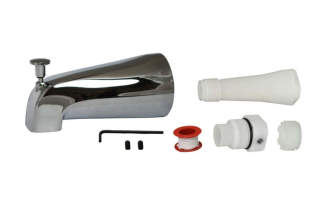
On 2020-03-29 by Derek Dethlefsen
I am having trouble with my tub spout. It won't fully block the water for the shower. So the shower head water pressure is weak.
Coming out of the wall is just a copper nipple, no threads. I have replaced the tub spout and water shoots back into the wall. Even though the tub spouts have a kit to attach to the smooth copper, would a threaded piece be more effective?
On 2020-02-16 - by (mod) - troubleshoot & fix a clogged sink/toilet combo prison toilet
Tommy,
Prison toilets generally work like other toilets but are constructed of stainless steel and may use a power flush or gravity flush system.
If your toilet has a flushing problem, start by plunging it vigorously with a toilet plunger.
See details at TOILET CLOG REPAIR, UN-BLOCK
Shown above are photos of a widely used sink-toilet combo from the Penal Ware brand sold by Acorn Engineering who sells to the justice system. The second photo of an Acorn toilet for sale on Ebay gives a view of the plumbing connections at the rear of the device.
This ACORN PARTS & TROUBLESHOOTING GUIDE [PDF] Acorn Engineering Co., POB 3527, Industry CA 91744 USA Tel: 626-336-4561 may help with repair of at least this brand of toilet/sink combination fixture.
Here is an EXAMPLE of installation instructions for one of the many models of this toilet:
PENAL-WARE TOILET SINK COMBO INSTALLATION INSTRUCTIONS [PDF] Acorn Engineering Co., POB 3527, Industry CA 91744 USA Tel: 626-336-4561
Shown below is a Kuge brand gravity-flush stainless steel toilet.
On 2020-02-16 by tommy cook
What style of toilets are the ones used in jails stainless steel tankless toilet sink combos. Need to know how it works so I can fix flushing problem
On 2019-12-14 by (mod) -
I'm not sure, Jacques - I'd want to know more about your system.
For example, if your geyser is a conventional water heater fed by pressurized water from a pump or from municipal water supply, and if your solar water heater operates at a lower pressure, you would not connect the two directly as you would be connecting high pressure city or pump water into a low pressure solar system.
Armed with brands and models we can check the specs and installation instructions from the manufacturers.
On 2019-12-14 by Jacques
Can l make a direct connection to hot water from solar panel to geyser hot water with out replacing standerd safety valve ,
On 2019-12-11 by (mod) - no hot water: what to check
Ned
The problem could be something as simple as an air-bound heating pipe loop that's not actually circulating hot water through your SuperStor.
Using the HTP Superstor WATER HEATER MANUAL [PDF] as an example, the company lists a number of things to check if there is no hot water. I'll post a snapshot of that checklist below.
You can find HTP Superstor water heater manuals at WATER HEATER MANUALS
[Click to enlarge any image]
On 2019-12-04 by Ned
I have a superstor SS-40 indierect water heater. It receives hot water but only cold comes out.
The zone valve was replaced and works fine and I had hot water for about two weeks; then the same problem came back. According to the panel, the thermostat is calling for hot water. I have also raised it up to 180 degrees with no change in water temp. It was replaced over a year ago. Any ideas what the problem could be? Thanks for your help
On 2019-11-10 by (mod) -
Yes if the pump has a very brief on time from the point at which the pressure control switch turns it on until the pressure control switch turns it off the most likely your tank is waterlogged and needs an air charge
On 2019-11-09 by Jim B.
I've been reading many articles on inspectapedia about well supply. I looks like my 20 gal. Pressure tank is undersized. But then I measured my pump flow and it was higher than I thought it could do. (17gpm vs 10gpm it was rated) Not sure why. The time from turning on pump til turns off is only 17 seconds which is a short run time, a type of short cycling?
I'm on my 5th pump in 20 years and would like to improve the setup if possible without unnecessary replacement of components. Just because something was originally put in doesn't mean it was right. (ie pressure tank size) And top it off, we have a low well replenish rate. So maybe too strong a pump? Could be related to sediment volume.
On 2019-11-09 by (mod) -
Jim I'm not sure I have a clear understanding of the situation; but in general if your water tank is water-logged you'd get only a small water charge in the tank.
If this tank uses an internal bladder see diagnostics and repair starting at WATER TANK BLADDERS
If it does not use an internal bladder you might want to start at WATER TANK AIR, HOW TO ADD
On 2019-11-09 by Jim B.
I have a 3/4hp 10gpm well pump, 250 ft down, 45 ft down to water. 20 gal pressure tank, 40-60 psi. Sediment challenge. Measured water from drain at tank at 17 sec for 5 gal. How can that be?(17 gpm?)
Should I get bigger tank for longer pump run and more drawdown capacity?
Maybe pinhole leak in bladder? Maybe pressure switch clog? 20 year old setup. Thanks!
On 2019-09-21 by (mod) -
In general, Alexander, yes, that's done all the time. Just be sure that the venting is adequate and that the drain lengths are within spec for distances to the vent and to the vertical wet drain; else the toilet flush can siphon out the shower trap.
On 2019-09-21 by Alexander Mo
Can a shower drain be connected to a toilet drain- the toilet would be between the shower and the main vent stack.
On 2019-08-13 by (mod) -
Dave:
Please see your question repeated (at the end of the article) along with my detailed reply now found at
SILLCOCK INSTALLATION & REPAIR
On 2019-08-12 by Dave
I am plumbing by myself, an addition to my home. In the addition, the plumbing will consist of; 1) a clothes washer connection, and drain. 2) a utility tub connection and drain. 3) A hose bib connection for outside use.
Once I have all the water and drain lines in place, do I have to charge the water lines with water, to pass the building code inspection or just have them run to where they will go, and I don't even have to have them connected to faucets etc? Will the inspector want to look at
my 'actual',/ physical, water connections, ( to the utility tub faucet and clothes washer water connections and the out door faucet) Thank you for this opportunity to ask my questions, and I look forward to reading your reply.
...
Continue reading at LEAK TYPES, WATER SUPPLY or DRAIN PIPES or select a topic from the closely related articles below, or see the complete ARTICLE INDEX.
Or see PLUMBING SYSTEM INSPECT DIAGNOSE REPAIR FAQs - questions & answers posted originally at this page.
Suggested citation for this web page
PLUMBING SYSTEM INSPECT DIAGNOSE REPAIR at InspectApedia.com - online encyclopedia of building & environmental inspection, testing, diagnosis, repair, & problem prevention advice.
Or see this
INDEX to RELATED ARTICLES: ARTICLE I NDEX to PLUMBING SYSTEMS
Or use the SEARCH BOX found below to Ask a Question or Search InspectApedia
Ask a Question or Search InspectApedia
Questions & answers or comments about plumbing system inspection, diagnosis, testing, & repairs
Try the search box just below, or if you prefer, post a question or comment in the Comments box below and we will respond promptly.
Search the InspectApedia website
Note: appearance of your Comment below may be delayed: if your comment contains an image, photograph, web link, or text that looks to the software as if it might be a web link, your posting will appear after it has been approved by a moderator. Apologies for the delay.
Only one image can be added per comment but you can post as many comments, and therefore images, as you like.
You will not receive a notification when a response to your question has been posted.
Please bookmark this page to make it easy for you to check back for our response.
IF above you see "Comment Form is loading comments..." then COMMENT BOX - countable.ca / bawkbox.com IS NOT WORKING.
In any case you are welcome to send an email directly to us at InspectApedia.com at editor@inspectApedia.com
We'll reply to you directly. Please help us help you by noting, in your email, the URL of the InspectApedia page where you wanted to comment.
Citations & References
In addition to any citations in the article above, a full list is available on request.
- [11] plumbing911.com/poly/ Polybutylene Plumbing Failures , Lots of Info about, but slow-loading busy site - appears dead 2024/01/24
- "Water Saving Tips: For Residential Water Use, Indoors and Out", Alliance for Water Efficiency, 300 W Adams Street, Suite 601 Chicago, Illinois 60606, Tel: 773-360-5100, 866-730-A4WE, Email: jeffrey@a4we.org, web search 12/14/11, original source: plumbingefficiencyresearchcoalition.org/
- "Danger in the Shower: 2008 Forum Looks at Hot Water", John Koeller, Home Energy, Jan/Feb 2009,
- In addition to citations & references found in this article, see the research citations given at the end of the related articles found at our suggested
CONTINUE READING or RECOMMENDED ARTICLES.
- Carson, Dunlop & Associates Ltd., 120 Carlton Street Suite 407, Toronto ON M5A 4K2. Tel: (416) 964-9415 1-800-268-7070 Email: info@carsondunlop.com. Alan Carson is a past president of ASHI, the American Society of Home Inspectors.
Thanks to Alan Carson and Bob Dunlop, for permission for InspectAPedia to use text excerpts from The HOME REFERENCE BOOK - the Encyclopedia of Homes and to use illustrations from The ILLUSTRATED HOME .
Carson Dunlop Associates provides extensive home inspection education and report writing material. In gratitude we provide links to tsome Carson Dunlop Associates products and services.


